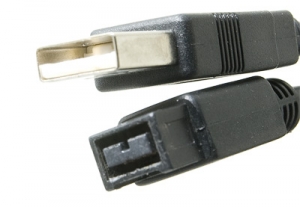
USB 2 is the next generation of the Universal Serial Bus, which the first USB products trickled out back in the Pentium days. USB 1.1 is, for the most part, available on the majority of today's computers. USB is a port that allowed users to be able to plug and unplug devices from their computer without having to reboot it.
USB 1.1 is still a widely accepted standard, but now, it is getting updated. With current gadgets out there, USB 1.1's standard is too slow to stay up with current demands. USB 1.1 had a speed of 12mbps, which is just a fraction of what today's USB 2 standard which boasts speeds of up to 480mbps, or 40 times faster than USB 1.1.
USB is the answer to replacing the "old" ports such as PS/2 , parallel and serial ports. With the availability of keyboards and mice that use this standard, people are slowly moving away from ps/2 devices. I personally still use PS/2, and those who threw out their ps/2 devices, might wish they haven't.
When something goes wrong with your computer and you can't boot into your operating system, well those who use USB are out of luck because PS/2 devices do not need drivers to be able to function, while usb keyboards and mice do.
What is Firewire?
Firewire aka IEEE 1394, has been out for quite a few years, only recently, it has become increasingly popular for PC users. Firewire has been available for Mac users for a while. Firewire is a tad slower than USB2; it's only 400mbps compared to USB2's 480mbps. Firewire does basically the same as USB, it allows you to swap devices "hotswapping" without turning off your computer and turning it back on.
There is one major diffence that benefits Firewire users is that it is isosynchronus. That means that if you have for example 3 devices, that all 3 would get 480mbps bandwidth to use, while USB2 is shared between devices. This is the ugly side of using USB2.
How do I get Firewire or USB 2?
Your motherboard might have already built in USB2 or Firewire ports or both respectively if your motherboard is under 2 years old. USB 2 and Firewire ports are being included more with the newer motherboards, but read the manual to see if you already have it.
If you don't have one or the other, there is an easy way of installing USB2 or Firewire or both in your computer, and that is by buying a PCI card. There are quite a few manufacturers that make these cards. You have the option of getting a PCI card with just USB2 ports, just Firewire and cards that have both. I personally would recommend getting a card that has both for future device purchases. It might cost a bit more, but then why buy another card? I would advise that you read the specs on the card before buying, but you shouldn't have a problem if you run Win98se and up.
Some insight on USB 1.1 products on usb2 ports
Some people might get confused with this but I will explain it nice and short. USB 2 devices will work on USB 1.1, it may not work great since there is a significant speed decrease. The device will not work as fast as it would if it was connect to a USB 2.0 port.
Second, devices that are designed for USB 1.1 will work on USB 2 ports, but there will be no speed increase. That device will continue to operate as if its being used on a USB 1.1 port.
Conclusion
When it comes down to it, Firewire and USB2 has both its disadvantges, and its advantages. I would personally choose Firewire over USB2 because it has been used a lot longer than USB2. There also seems to be a lot more multimedia devices, such as DV Cameras, that use the Firewire port compared to USB2, and there are harddrive that also tend to use Firewire as its connection than USB2.
But, for those who do not have either USB2 or Firewire and need one of them, to be on the safe side, I would personally buy a card that supports both, for the simple fact as stated above, you would have both areas covered.
